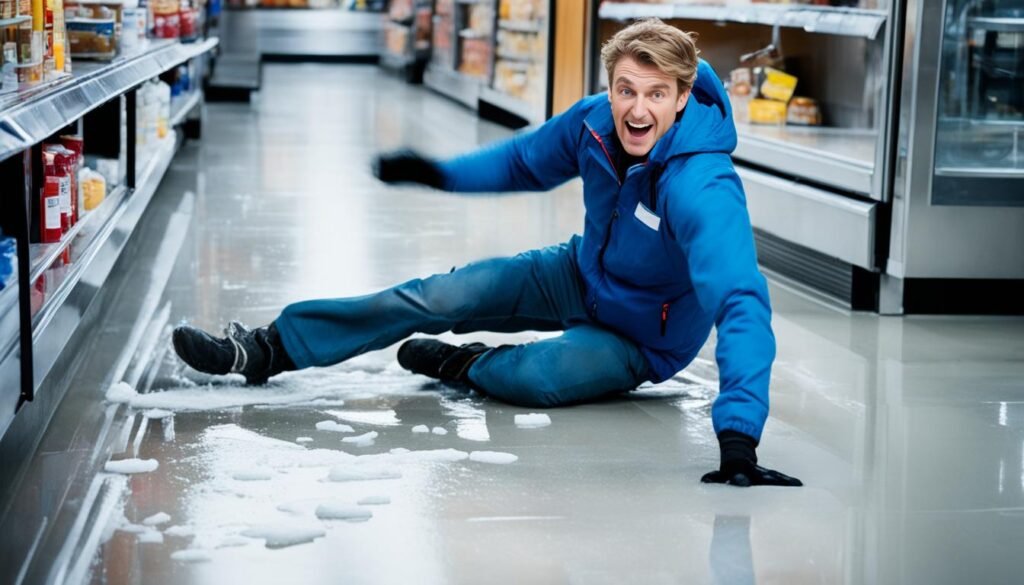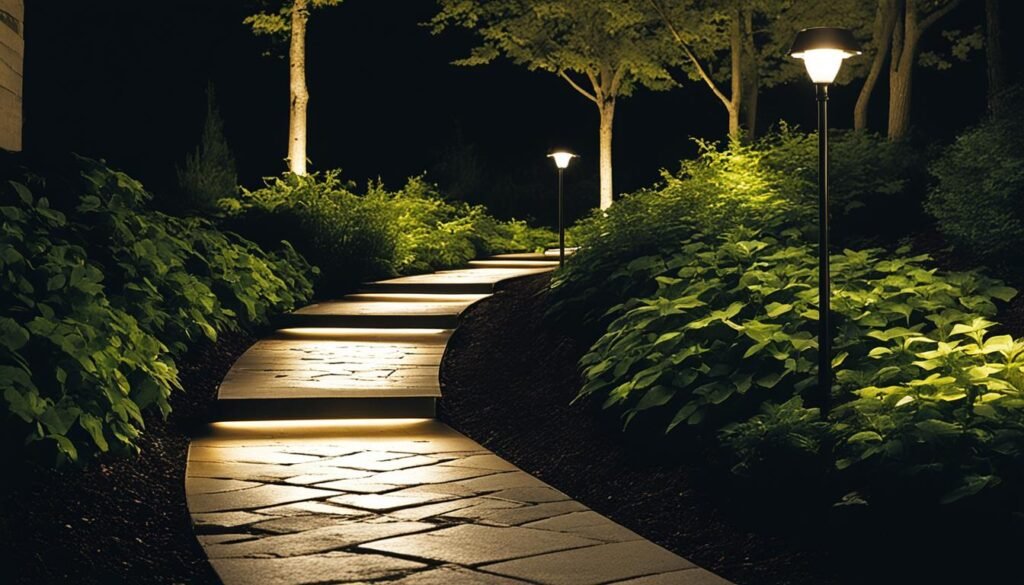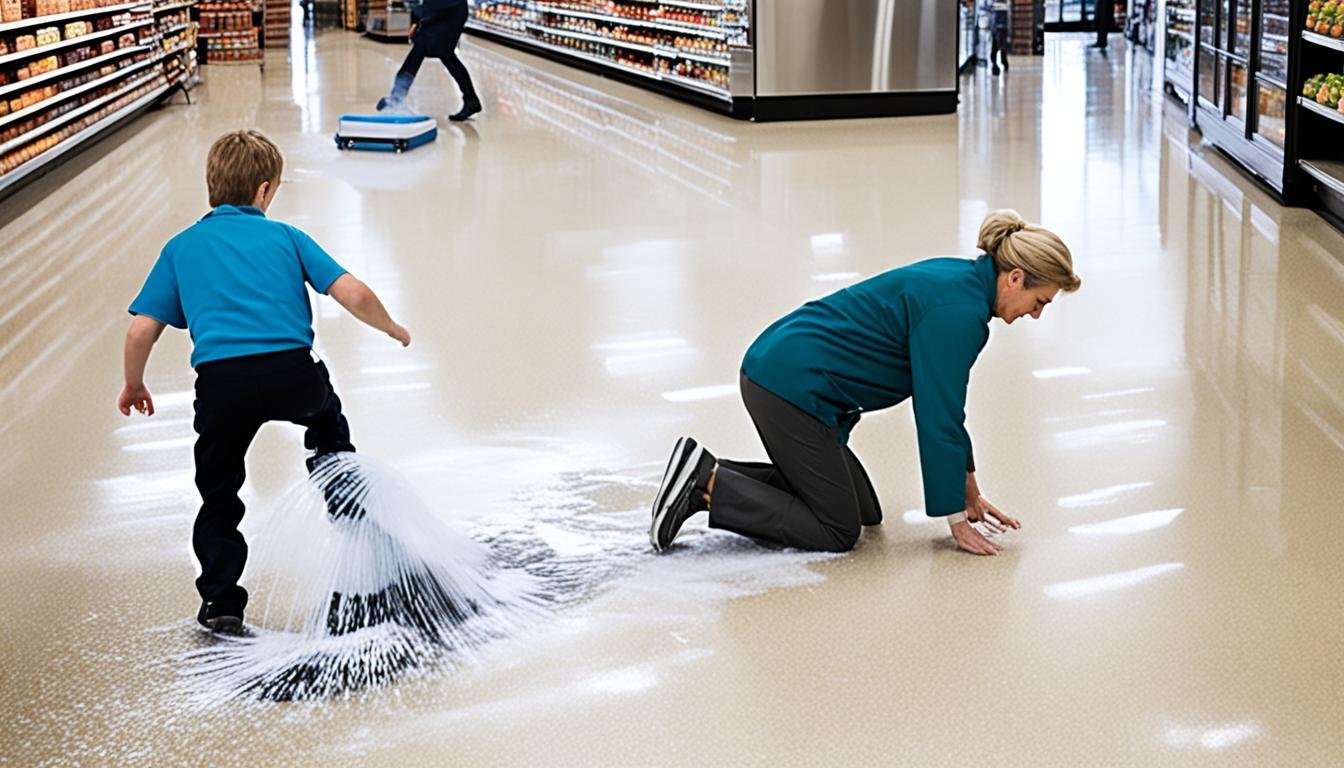Every year, slip and fall accidents cause millions of injuries and even death. These events are often due to avoidable reasons. They pose a big risk to people of all ages, causing serious harm. Knowing the top reasons for these accidents helps keep everyone safer.
Key Takeaways:
- Slip and fall accidents are responsible for numerous injuries and deaths annually.
- Improper floor maintenance, poor visibility, and lack of slip-resistance on walking surfaces are common causes of these accidents.
- Failing to promptly clean up spills and a lack of handrails also contribute to slip and fall hazards.
- Weather conditions and inadequate workplace safety practices are additional factors that can lead to these accidents.
- Nursing home neglect is a significant cause of slip and fall accidents among the elderly.
- By addressing these common causes and taking preventive measures, you can reduce the risk of slip and fall accidents and promote a safer environment for everyone.
Slippery Floors and Walking Surfaces
Slippery floors and surfaces are a top reason for slip and fall accidents. They may result from not keeping floors clean or well-maintained. Also, not having floors with enough grip can lead to accidents. Plus, not cleaning spills quickly can cause dangerous conditions.

Slippery floors are very risky, especially where a lot of people walk like entrances, bathrooms, and kitchens. These places often get spills from water, oils, and other stuff making the floors very slippery. If not cleaned regularly, dirt and dust build up, making floors even more risky.
To prevent accidents, keep floors well-maintained. Clean, sweep, and mop regularly to remove dirt and debris. Using the right cleaning products and methods helps keep floors safe.
Businesses should think about using mats or anti-slip solutions to improve grip on floors. These steps can add extra safety and lower the chance of falling.
Quickly dealing with spills is key to avoiding accidents. Companies need a clear plan for finding and cleaning spills. Training staff to react fast to spills reduces risks for everyone.
Along with keeping floors clean and cleaning spills quickly, it’s vital to warn people about slippery spots. Proper signs or barriers can alert people to be careful and prevent accidents.
| Preventive Measures | Benefits |
|---|---|
| Regular floor cleaning and maintenance | Enhances slip-resistance and removes potential hazards |
| Use of floor mats and anti-slip treatments | Increases traction and reduces the risk of slips |
| Prompt spill clean-up | Prevents accidents by eliminating slippery conditions |
| Clear signage and barriers | Alerts individuals to potentially slippery areas |
By taking these steps, companies can greatly lower the chance of slip and fall accidents on slippery floors and surfaces. Keeping employees and visitors safe must always be a priority.
Poor Lighting and Visibility
Poor lighting often causes slip and fall accidents. It puts individuals at risk because it’s hard to see and avoid dangers. Businesses and property owners should ensure good lighting. Areas such as walkways, parking lots, and stairwells need it most.
Well-lit walkways are key in making places safer. With better lighting, people can see where they’re going. This helps prevent accidents by spotting dangers early.
Not having enough light makes it tough to see problems like uneven surfaces. Good lighting helps everyone see better and prevents accidents. It makes spaces safer for everyone.
“Proper lighting is essential to ensure the safety of individuals and prevent slip and fall accidents. By investing in adequate lighting solutions, businesses and property owners can create a safe environment for everyone.”
Good lighting does more than just prevent accidents. It also makes a place more secure. Bright areas can stop crimes and make people feel safer when they visit a location.
Benefits of Proper Lighting:
- Enhanced visibility
- Improved safety
- Reduced risk of accidents
- Deterrence of criminal activities
Good lighting shows that businesses care about safety. Keeping walkways bright is a way to look out for everyone’s well-being.

| Preventive Measures | Benefits |
|---|---|
| Install bright and energy-efficient lighting | Improved visibility and reduced accident risk |
| Regularly inspect and replace faulty light fixtures | Maintained lighting quality |
| Ensure adequate lighting in stairwells and parking areas | Enhanced safety and reduced risk of falls |
| Utilize motion sensor lights for added security | Deterrence of criminal activities |
Lack of Handrails
Not having handrails increases the chance of slipping and falling, especially on stairs and ramps. Handrails are important because they help people keep their balance. Without them, it’s easier to lose your footing and get hurt from falling.
It’s up to property owners to make sure handrails are in place and well-maintained. This means checking them often for any damage and fixing them right away. Keeping handrails sturdy and in good shape helps prevent accidents. This makes places safer for everyone.
Following safety rules for handrails is key. They need to be at the right height for easy gripping. Handrails must also be firmly fixed to walls or the staircase itself. Choosing materials that won’t slip ensures a safer grip and reduces accidents.
Making sure handrails are safe cuts down the risk of falling. Proper handrail care is important. It makes areas with stairs and ramps safer and helps avoid injuries from falls.
| Benefits of Handrails | Tips for Handrail Maintenance and Safety |
|---|---|
|
|
Proper handrails provide stability and support. They help lower the chance of slips and falls.
Weather Conditions
Outdoor weather can make slip and fall risks worse. Icy and snow-covered paths are very dangerous in winter. It’s important for people who own properties and cities to act to prevent accidents.
To lower slip and fall risks outside, keeping sidewalks clear is key. Shoveling sidewalks and plowing streets create safer paths. Also, using salt or ice-melt on walkways and steps helps people not slip.
Following winter safety tips is a must to avoid weather-related accidents. This means keeping an eye on the forecast and starting to remove snow and ice right away. By doing this, property owners can make outside safer for everyone.
It’s critical to stop slip and fall accidents for everyone’s safety. Keep outdoor areas well-maintained and stick to winter safety steps. This helps lower the dangers of bad weather conditions.
Improper Training and Workplace Safety
Slip and fall accidents often happen at work because employees aren’t properly trained. They may not know how to safely move around job sites or use equipment. Thus, it’s the employer’s job to train their staff well to prevent these accidents.
Every company should put safety first. Simple steps like keeping floors dry and clear, having clear signs for hazards, and regularly checking the workplace can lower accident risks. Fixing any dangers found during these checks is also critical.
It’s also crucial to have clear safety rules, including the right way to lift things and the need for safety gear. Teaching the value of safety keeps everyone safer at work.
“Proper training and workplace safety practices are crucial in preventing slip and fall accidents in the workplace. By investing in training programs and implementing safety protocols, employers can protect their employees and create a culture of safety.”
Workplace safety is a team effort. Both bosses and workers must keep an eye out for dangers. Speaking up about hazards and having regular safety training helps everyone stay alert to risks.
Benefits of Proper Training and Workplace Safety
Good training and safety habits are good for everyone at a company:
- Reduced risk of workplace accidents and injuries
- Increased employee morale and satisfaction
- Enhanced productivity and efficiency
- Lower healthcare and insurance costs
- Compliance with regulatory requirements
- Improved reputation and trust among clients and customers
Putting safety and training first means fewer accidents at work. It protects employees and keeps the company from facing legal or financial problems.
Stopping accidents starts with recognizing dangers, training employees properly, and promoting a safety-first attitude. This ensures employees stay safe and happy at work.
Nursing Home Neglect
Slip and fall accidents in nursing homes are a big worry. Elderly people often lose their balance easily. The CDC says one in three people over 65 fall each year. Many of these falls happen in nursing homes.
Nursing home neglect can lead to more accidents. If staff and administrators don’t help or watch residents closely, dangers increase. Not enough care or supervision makes slip and fall accidents more likely.
Stopping these accidents is key to keeping residents safe. Nursing homes need to check on residents often and have enough staff. They also must keep their place safe and in good condition. This helps lower the risk of accidents.
Keeping residents safe must be a top priority for nursing homes. They need to care for residents well and take steps to avoid falls. By doing these things, nursing homes can make a safer space for everyone and prevent many accidents.
Conclusion
Slip and fall accidents often lead to injuries and can have serious outcomes. By knowing the common causes, we can avoid them. Things like keeping floors clean, good lighting, and adding handrails help a lot. It’s also key to handle weather hazards, train staff well, and ensure nursing homes are safe.
After a slip and fall, getting advice from a skilled lawyer is vital. Super Attorneys Of Irvine offer expert guidance. You can reach out to them at 949-996-9546 or visit their website businesslawyersirvine.com for the right attorney. Acting properly and legally can make places safer and cut down on slip and fall risks.
FAQ
What are the most common causes of slip and fall accidents?
How can businesses prevent slip and fall accidents caused by slippery floors and walking surfaces?
How does poor lighting contribute to slip and fall accidents?
Why is the lack of handrails a common cause of slip and fall accidents?
How can weather conditions contribute to slip and fall accidents?
What can employers do to prevent slip and fall accidents in the workplace?
How does nursing home neglect contribute to slip and fall accidents?
Where can I find legal assistance for slip and fall accidents?
Source Links
- https://www.injuryattorneyfla.com/common-causes-of-slip-and-fall-accidents.html
- https://personalinjurysandiego.org/slip-and-fall/6-most-common-causes-of-slip-and-fall-accidents/
- https://arashlaw.com/8-common-causes-of-slip-fall-accidents-including-15-example-scenarios-and-californias-10-most-prevalent-statistics/

